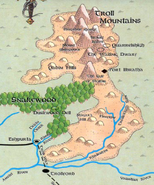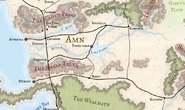Eshpurta, the "Shield City" of Amn,[7] was a bustling military trade town in eastern Amn.[3] Before the Sothillisian War in 1370 DR, Eshpurta contained about 70,000 townsfolk with another 10,000 in the surrounding ranches and farms. Additionally, there were 25,000 Amnian troops garrisoned in the city, bringing the approximate population to 105,000. During the trade season, the population could reach 175,000.[5] During the war, a census in 1372 DR reported the population as less than 25,000,[note 1] which downgraded the once-thriving metropolis to a large city.[3]
Geography[]
Eshpurta was located at the confluence of Trifin Creek and the River Rimril where they merged to later join the Amstel River, which eventually flowed into Lake Esmel in the heart of Amn.[note 2] Eshpurta was south of the Snakewood, south and west of the Troll Mountains, north of Trollford, and far to the east of Keczulla along the Eshpurta Road.[8]
Government[]
This fortified city had a strong military tradition and was governed by a council of six, called the Shield Council, whose members were the leaders of the local merchant families and clans. The unelected "advisor" of the Shield Council was General Labak Craumerdaun who held the position mainly by force of personality. The fact he also had troops garrisoned in the city certainly didn't hurt his standing, and the council members usually listened to his advice and even curried his favor.[5][6] The Shield Council members in early 1370 DR[9] were:[10]
- Lord Marcos Craumerdaun
- Lord Mikaal Dannihyr
- Lady Jazzomyn Gheldieg
- Lord Tanis Keltronn
- Lord Jharvex Krimmevol
- Lord Bhaem Shumokh
- General Labak Craumerdaun (advisor)
- Herald Swanmantle, Ard Roton (advisor)
Trade[]
Eshpurta was known as the "Shield City" because it had more troops stationed there than anywhere else in Amn. The business of the city largely revolved around the military with hundreds of blacksmiths, weaponsmiths, armorers, leatherworkers, stablekeepers, etc. which occupied the northern and western quadrants of the city. Large mining operations pulled iron and nickel out of the Troll Mountains to feed the smelters and ultimately produce the trappings of martial might. The eastern portion of the city was almost exclusively dedicated to the mining and related industries.[7] The chief exports of Eshpurta were arms, armor, military equipment and training, mercenaries, and iron ore.[5] Less lucrative but important for civic pride, the southern ward of the city was home to sculptors, artisans, and musicians.[7]
Defenses[]

Eshpurta city layout
The city was naturally defended by creeks or rivers on three sides, as well as walls fortified with towers around the entire city proper. Three large gates connected the city to the major roads and the countryside. The southwest gate led to a crossing of the swiftly rushing[7] Trifin creek and the Eshpurta Road that ran westward to Keczulla. Just up from this road was the Golden Fortress, overlooking the confluence of the creek and the river. The gate in the south-southeast opened on a crossing of the River Rimril and connected to the South Road to Trollford. The north gate led to the settled countryside and eventually the Snakewood.[5][8]
Troops[]
Before the Sythillisian War, Eshpurta had a garrison of the Amnian Council Army 25,000 strong. This included 18,000 troops, 6,300 officers, and about 700 support personnel such as weapon and armor smiths, instructors, logistics managers, cooks, etc. In addition, the Golden Fortress housed some 3,000 trainees and the city was policed by the Shield Militia of 1,400–2,000[6] mounted officers, which was under the direction of the Shield Council.[5]
History[]
In the Year of Faltering Fires, 491 DR, Kadar el Aktorral,[11] an ambitious Calishite noble, led a group of immigrants from Tethyr and Calimshan to the lands east of Lake Esmel and founded the Duchy of Cortryn in what was formerly the halfling realm of Meiritin and the Shoon territory of Valashar. Eshpurta was established as a fishing village and was the northernmost city in Cortyrn.[12] The Duchy of Cortryn lasted until the Year of Visions, 731 DR when a beholder cult called the Ring of Eyes wiped out the ruling house and captured Cortryn. The Ring was eventually defeated and in the Year of Drifting Stars, 760 DR, Amn conquered the Duchy and added it to its territory.[13]
Rumors and Legends[]
- Eshpurta was one of the few cities that contained a gate to Swordsmere, the secret subterranean lake surrounding Herald's Hall.[14][15]
- The Shadow Thieves were thought to control or operate some gambling establishments and festhalls, and run a payday loan business that appealed to some soldiers. All rogue activity was kept inconspicuous by necessity due to the heavy military presence in the city. If any misconduct was blatant enough to be noticed at the top of the chain of command, the General was not above turning the tables and having a siege weapon misfire and accidentally hit these shady businesses.[16]
Notable Locations[]
Inns and Taverns[]
- The Fierce Flumph — tavern[5]
- The Hamstrung Giant — inn/tavern, had comfortable beds, good food, moderate prices[6][16]
- The House of the Iron Rose — boarding house, exclusive to officers and the well-to-do; top quality, high prices[16]
- The Knight's Detente — inn/festhall, rowdy, catered to soldiers; low quality, medium priced[16]
- The Roots of the Earth — tavern/shrine to Grumbar, rowdy, catered to miners; low quality, cheap[16]
- Three Roldons — tavern, opulent, quiet, and very exclusive; good food/drink, high priced[16]
Shops[]
Temples and Shrines[]
- The Towers of the Vengeful Hand (Tempus)[4][5]
- The Towers of Willful Suffering (Ilmater)[4][5]
- The Golden Fortress housed chapels to Helm, Tempus, Torm, and Tyr[4][16]
- Shrines to nearly every other deity worshiped in Faerûn[4][16]
Notable Inhabitants[]
Lords and Ladies[]
Bhaem Shumokh • Jazzomyn Gheldieg • Jharvex Krimmevol • Marcos Craumerdaun • Mikaal Dannihyr • Tanis Keltronn • Varytha Gheldieg
Merchants and Workers[]
Cargunn • Carn Wittsome • Eudhis Bhamm • Marlyn "Luxor" Lurraxol • Nethris Perndle
Military Personnel[]
Balacer Macefist • Dannal Harftevor • Labak Craumerdaun • Namble Swiftleg
Clergy[]
Benitus • Heldatha Dhussta • Jak Errins • Niskam Tresdaap • Peris Whallnsor • Torgan Minerson
Wizards[]
Due to the general censure of arcane spellcasters in Amn, these persons kept their wizardly inclinations private.
Dannal Harftevor • Eudhis Bhamm • Marlyn "Luxor" Lurraxol • Varytha Gheldieg • Vimal Craumerdaun
Other[]
Ard Roton • Korienna Redarm
Appendix[]
Notes[]
- ↑ This sudden drop in population is unexplained and is likely a retcon. Given that Eshpurta was far from the Sothillisian War and apparently did not come under attack, even if the entire military sector left the city and never returned the population would still be at least twice this number.
- ↑ The map of Eshpurta on page 39 of Lands of Intrigue Book Two: Amn marks the Amstel River as beginning at the convergence of Trifin Creek and the River Rimril, and page 45 describes the river as flowing "from Eshpurta" and being fed by the Khalleshyr and the River Valashar. However, three sources, Empires of the Sands (p. 18), Castle Spulzeer (p. 21), and Lands of Intrigue Book Two: Amn itself (p. 43) indicate that the Amstel River began east of Trollford, the only safe place where it could be crossed for 75 miles. Finally, the wording on page 38 of Lands of Intrigue Book Two: Amn implies that the river began "at Trollford," where the Khalleshyr joined it. It is consistent that Trifin Creek, the Rimril, the Khalleshyr, and the Valashar all fed the Amstel. It seems possible that the north–south fork from Eshpurta and the east–west fork from Trollford were both called the Amstel. It is also possible that the map on page 39 of Lands of Intrigue Book Two: Amn is in error and that references to "from Eshpurta" and "at Trollford" are not meant to be precise but rather as general descriptions of the area, i.e., "near Eshpurta" and "in the region of Trollford." If this latter interpretation is correct, then page 43 of Lands of Intrigue Book Two: Amn would clearly indicate that the River Valashar became the Amstel River when the Khalleshyr joined it 40 miles east of Trollford. According to page 38, then, Trifin Creek flowed into the Rimril at Eshpurta, and it was the Rimril, not the Amstel, that flowed south from Eshpurta. The Rimril then joins the Amstel west of Trollford.
Gallery[]
from 2nd ed. Lands of Intrigue
Appearances[]
References[]
- ↑ Karen Wynn Fonstad (August 1990). The Forgotten Realms Atlas. (TSR, Inc), p. 5. ISBN 978-0880388573.
- ↑ Doug Stewart (November 1997). Castle Spulzeer. (TSR, Inc), p. 14. ISBN 978-0786906697.
- ↑ 3.0 3.1 3.2 3.3 Ed Greenwood, Sean K. Reynolds, Skip Williams, Rob Heinsoo (June 2001). Forgotten Realms Campaign Setting 3rd edition. (Wizards of the Coast), p. 154. ISBN 0-7869-1836-5.
- ↑ 4.0 4.1 4.2 4.3 4.4 4.5 4.6 4.7 Doug Stewart (November 1997). Castle Spulzeer. (TSR, Inc), p. 19. ISBN 978-0786906697.
- ↑ 5.00 5.01 5.02 5.03 5.04 5.05 5.06 5.07 5.08 5.09 5.10 Steven E. Schend (August 1997). “Book Two: Amn”. In Roger E. Moore ed. Lands of Intrigue (TSR, Inc.), p. 39. ISBN 0-7869-0697-9.
- ↑ 6.0 6.1 6.2 6.3 Doug Stewart (November 1997). Castle Spulzeer. (TSR, Inc), p. 18. ISBN 978-0786906697.
- ↑ 7.0 7.1 7.2 7.3 Steven E. Schend (August 1997). “Book Two: Amn”. In Roger E. Moore ed. Lands of Intrigue (TSR, Inc.), p. 38. ISBN 0-7869-0697-9.
- ↑ 8.0 8.1 Map of the Lands of Intrigue included in Steven E. Schend (August 1997). Lands of Intrigue. Edited by Roger E. Moore. (TSR, Inc.). ISBN 0-7869-0697-9.
- ↑ Steven E. Schend (August 1997). “Book Two: Amn”. In Roger E. Moore ed. Lands of Intrigue (TSR, Inc.), p. 26. ISBN 0-7869-0697-9.
- ↑ Steven E. Schend (August 1997). “Book Two: Amn”. In Roger E. Moore ed. Lands of Intrigue (TSR, Inc.), p. 40–41. ISBN 0-7869-0697-9.
- ↑ Brian R. James, Ed Greenwood (September 2007). The Grand History of the Realms. Edited by Kim Mohan, Penny Williams. (Wizards of the Coast), p. 89. ISBN 978-0-7869-4731-7.
- ↑ Brian R. James, Ed Greenwood (September 2007). The Grand History of the Realms. Edited by Kim Mohan, Penny Williams. (Wizards of the Coast), p. 88. ISBN 978-0-7869-4731-7.
- ↑ Brian R. James, Ed Greenwood (September 2007). The Grand History of the Realms. Edited by Kim Mohan, Penny Williams. (Wizards of the Coast), p. 101. ISBN 978-0-7869-4731-7.
- ↑ Ed Greenwood (September 1993). The Code of the Harpers. Edited by Mike Breault. (TSR, Inc.), p. 81. ISBN 1-56076-644-1.
- ↑ Richard Baker, Ed Bonny, Travis Stout (February 2005). Lost Empires of Faerûn. Edited by Penny Williams. (Wizards of the Coast), p. 119. ISBN 0-7869-3654-1.
- ↑ 16.0 16.1 16.2 16.3 16.4 16.5 16.6 16.7 Steven E. Schend (August 1997). “Book Two: Amn”. In Roger E. Moore ed. Lands of Intrigue (TSR, Inc.), p. 40. ISBN 0-7869-0697-9.




